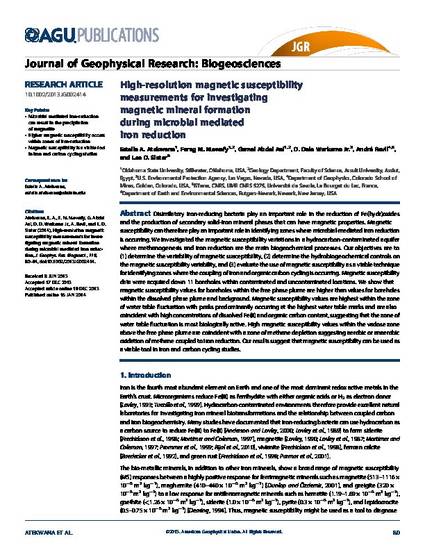
Disimilatory iron-reducing bacteria play an important role in the reduction of Fe(hydr)oxides and the production of secondary solid-iron mineral phases that can have magnetic properties. Magnetic susceptibility can therefore play an important role in identifying zones where microbial-mediated iron reduction is occurring. We investigated the magnetic susceptibility variations in a hydrocarbon-contaminated aquifer where methanogenesis and iron reduction are the main biogeochemical processes. Our objectives are to (1) determine the variability of magnetic susceptibility, (2) determine the hydrobiogeochemical controls on the magnetic susceptibility variability, and (3) evaluate the use of magnetic susceptibility as a viable technique for identifying zones where the coupling of iron and organic carbon cycling is occurring. Magnetic susceptibility data were acquired down 11 boreholes within contaminated and uncontaminated locations. We show that magnetic susceptibility values for boreholes within the free phase plume are higher than values for boreholes within the dissolved phase plume and background. Magnetic susceptibility values are highest within the zone of water table fluctuation with peaks predominantly occurring at the highest water table marks and are also coincident with high concentrations of dissolved Fe(II) and organic carbon content, suggesting that the zone of water table fluctuation is most biologically active. High magnetic susceptibility values within the vadose zone above the free phase plume are coincident with a zone of methane depletion suggesting aerobic or anaerobic oxidation of methane coupled to iron reduction. Our results suggest that magnetic susceptibility can be used as a viable tool in iron and carbon cycling studies.
- Borehole,
- Carbon Cycle,
- Data Acquisition,
- Dissolution,
- Hydrobiology,
- Iron,
- Magnetic Mineral,
- Magnetic Susceptibility,
- Microbial Activity,
- Plume,
- Vadose Zone,
- Water Table,
- Iron Reduction,
- Magnetic Susceptibility,
- Magnetite
Available at: http://works.bepress.com/estella-atekwana/39/